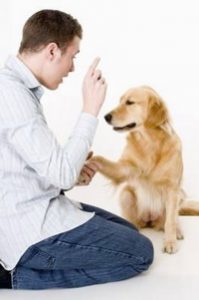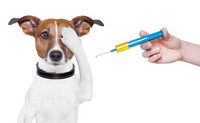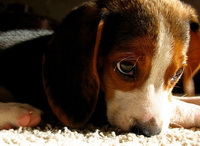Puppy training for the main teams
 The trainers know that each team has its own optimal training time. A two-month-old puppy easily learns positive skills related to an activity. It is easy to teach him to run up to the call, give a paw, run after the ball. However, with such a crumb is quite difficult to work on the shutter speed. This feature is associated with the non-simultaneous development of excitatory and inhibitory systems of the brain. In other words, an active and restless puppy hardly assimilates inhibiting and prohibiting commands. If you start a forced learning to restrain before the age of three months, then at best a lot of effort will be spent with a minimum of results, at worst a breakdown of the nervous system will occur, requiring the cessation of classes. However, even a small puppy must learn to control his behavior.
The trainers know that each team has its own optimal training time. A two-month-old puppy easily learns positive skills related to an activity. It is easy to teach him to run up to the call, give a paw, run after the ball. However, with such a crumb is quite difficult to work on the shutter speed. This feature is associated with the non-simultaneous development of excitatory and inhibitory systems of the brain. In other words, an active and restless puppy hardly assimilates inhibiting and prohibiting commands. If you start a forced learning to restrain before the age of three months, then at best a lot of effort will be spent with a minimum of results, at worst a breakdown of the nervous system will occur, requiring the cessation of classes. However, even a small puppy must learn to control his behavior.
Education begins at home, in a well-known environment – so the baby will be less distracted by foreign objects, sounds and smells. The lesson will be ineffective if the dog wants to sleep, has just eaten or is too played up. As a food reward, stock up on tasty slices of boiled liver, vitamin drops, or dry food pellets. Be friendly and calm so that the young student will feel your approval and not be nervous.
If your baby is 2 months old, you can easily train him in the Sit! Command. To do this, take a piece of treat and, holding it over your puppy’s head, slowly move your hand back. Trying to reach for food, the puppy will tilt its head back and sit down in order not to fall on its back. Once this has happened, praise him with a soft tone (“Good! Sit!”) And give the reward. If not everything goes smoothly, do not fall into despair and in no case punish the puppy. Try to repeat the exercise again. Do not force the puppy to remain in a sitting position for too long – for the first time, 5 seconds is enough. At the end of the lesson, let the child know that he is free – joyfully command “Walk!” And at the same time make a hand gesture in the direction away from you.
An introduction to the training of such a “liberating” team is necessary, as it puts the dog in rest mode and relieves tension. Remember that a dog should never arbitrarily cancel the execution of a command – for example, jump up from a lying position or, conversely, lie down when you give the command “Sit!”. Only the owner has the right to cancel this or that team. The command “Walk!” Means that the dog can behave at its own discretion. Over time, when the puppy grows up, you can relieve stress by replacing the static team with a dynamic one and combining, for example, the command “Sit!” And “To me!”. Such an approach very much disciplines the dog, making it more attentive and docile.
Repeat the exercise “Sit!” During the day 2-3 times, no more. Otherwise, learning can quickly bore your pet. Work with enthusiasm. If the baby is wrong, then correct it without irritation and negativity. Be sure to consider the characteristics of your pet’s temperament. Phlegmatic and heavy mastiffs, dogmas, St. Bernards, Newfoundlands, it is easier to master static postures than restless Dobermans and terriers, who at first are able to sit quietly for only a few seconds. However, this will be your overall small victory.
The “Lie!” Command is worked out a little later. It is especially hard given to active and restless breeds (terriers, Dobermans, Dalmatians), in which the processes of nervous regulation (arousal and inhibition) are not balanced. However, in any case, the impact on the puppy should not be harsh and ultimatum. You can not use explicit coercion. You can not punish the baby. Can not be annoyed. You must remember that the puppy’s unformed psyche is vulnerable and impressionable, and the negative experience can later become the cause of difficult to eradicate phobias. At such a young age, you cannot expect perfection from a puppy – the “pure” execution of a team cannot be done by a child. Your most important function is to indicate the right path. If at first the puppy does at least part of the exercise, at least a symbolic movement, at least a try, be sure to praise it!
Hold the treat in front of the puppy’s nose, then lower it lower, at the same time pulling the arm forward and thereby forcing the puppy to pull for a treat. Hold the baby back and at the same time give the command “Lie down!”. It is possible that the pupil will not immediately fall into an exemplary pose. He can only stretch his neck and fall on his front paws, while the tail and the croup will stick up. Gently press the back of the puppy to the floor. And if the baby at the same time jump on all four paws, you have to start all over again. When the dog finally lies down – praise him (“Well, lie down!”) And give him a treat. Let the puppy remain in this position for a few seconds, and you at this time do not forget to praise him with a tender voice. Then release the puppy team “Walk!”.



